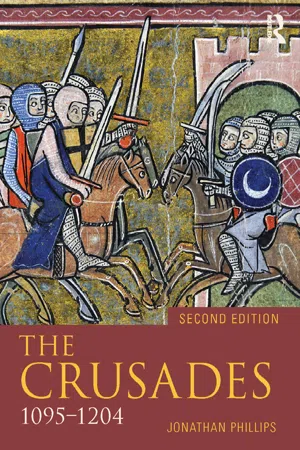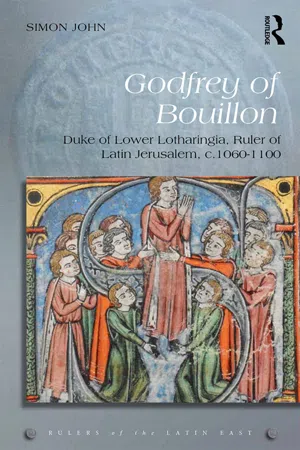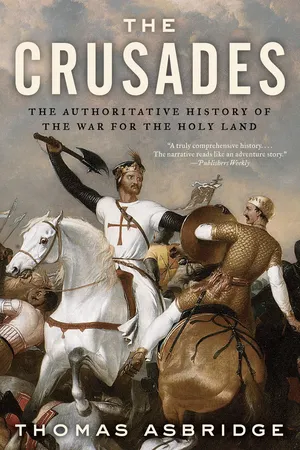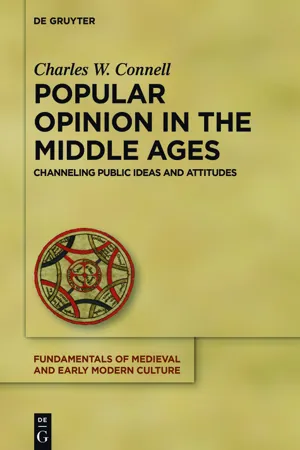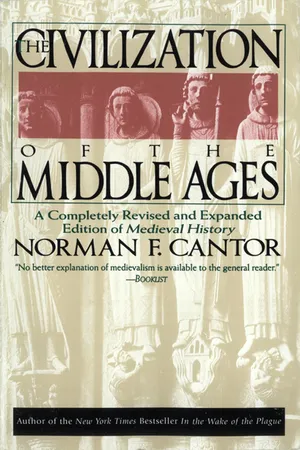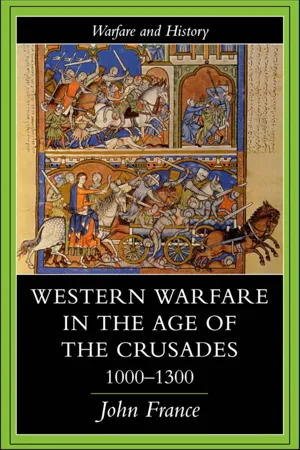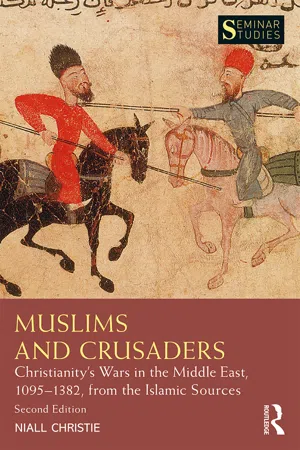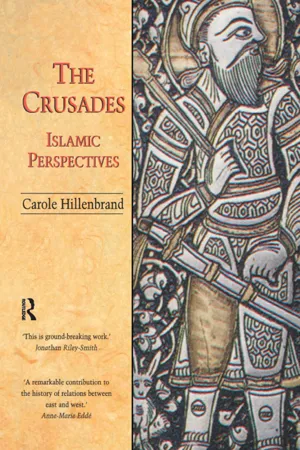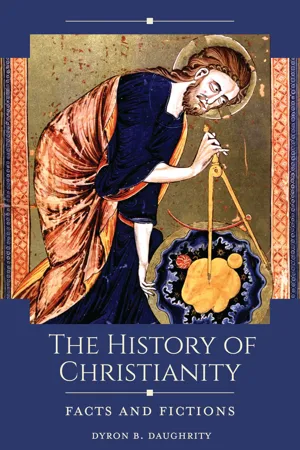History
First Crusade
The First Crusade was a military expedition launched by Western European Christians in 1096 with the goal of recapturing Jerusalem and the Holy Land from Muslim rule. It resulted in the successful capture of Jerusalem in 1099, establishing several Christian states in the region. The First Crusade marked the beginning of a series of religious wars known as the Crusades.
Written by Perlego with AI-assistance
Related key terms
11 Key excerpts on "First Crusade"
- eBook - ePub
- Jonathan Phillips(Author)
- 2014(Publication Date)
- Routledge(Publisher)
2 The First CrusadeO n 27 November 1095, at the end of a great church council at Clermont in central France, Pope Urban II launched the First Crusade – a call to free the holy city of Jerusalem from the hands of the Muslims. The response to his appeal was quite remarkable: spectators at Clermont interrupted his speech with cries of ‘God wills it!’ and hundreds begged to join the expedition. News of the crusade spread rapidly through Christian Europe; Fulcher of Chartres, a participant in the expedition, wrote that people ‘of any and every occupation’ took the cross. Once the crusaders had assembled he commented: ‘whoever heard of such a mixture of languages in one army, since there were Franciens, Flemings, Frisians, Gauls, Allobroges [Savoyards], Lotharingians, Allemani [Swabians], Bavarians, Normans, Englishmen, Scots, Aquitanians, Italians, Dacians [Danes], Apulians, Iberians, Bretons, Greeks and Armenians’ (Fulcher of Chartres, tr. Murray, 2011: 107). Representatives of the last two groups probably joined the expedition en route, but the remainder had been attracted by Urban’s initial call to arms. The crusade therefore appealed to people from almost every level of society right across Christian Europe.THE APPEAL OF THE First CrusadeWhy had Urban’s message provoked such a reaction? The pope had managed to draw together a number of key concerns and trends in late eleventh-century society and synthesised them into a single, highly popular idea. As we noted in the introduction, spiritual issues were a prominent factor governing peoples’ lives at the time of the First Crusade. It was an intensely religious age: the number of saints’ cults was increasing, along with interest in relics and the observation of feast days. Pilgrimage – both local and international – and monastic life flourished. Sin was ubiquitous in everyday life, particularly in the violent society of the late eleventh century and the need for all people whether rich or poor, nobles or labourers – to atone for their actions is vital in explaining the level of enthusiasm for the First Crusade. Pope Urban was astute enough to pull together these familiar points: contemporary religious zeal, the popularity of pilgrimage, concern for the afterlife and the problem of knightly violence, to form the core of the idea of the crusade. He also offered something new, innovative and highly attractive. A decree from the Council of Clermont records the essence of his message: ‘Whoever for devotion alone, not to gain honour or money, goes to Jerusalem to liberate the Church of God can substitute this journey for all penance’ (Riley-Smith and Riley-Smith, 1981: 37). - eBook - ePub
The Crusades
A Beginner's Guide
- Andrew Jotischky(Author)
- 2015(Publication Date)
- Oneworld Publications(Publisher)
1 What were the Crusades? Toward the end of the first decade of the twelfth century, a monk from northern France sat down to write an account of the First Crusade, which had captured Jerusalem from the Seljuq Turks in 1099. He was looking back over the events of ten years before, in which a force of perhaps 60,000 mostly French, Flemish, Normans, Germans and Italians, including fighting men and unarmed pilgrims, men and women, had travelled from western Europe across the Balkans and modern-day Turkey into Syria, and south to Jerusalem. Only a fraction of the original force survived the three-year odyssey, but the remnants, battered by the climate, the hazards of travel and shortages of food and fodder for their horses, seized the city of Jerusalem amid scenes of slaughter in July 1099. The monk, Robert of Rheims, struggled to find a similar phenomenon with which to compare the First Crusade. In the end, he decided that it was, simply, the most important event in human history since the birth of Jesus Christ. There are very few historical phenomena that are as susceptible to re-invention as the Crusades. The term has been used and re-used so many times since its original coining that it has come to have a much wider application than originally intended. For much of the twentieth century, in the Western world, ‘crusade’ was used metaphorically in public discourse and invariably in contexts where some moral virtue was to be associated in the reader’s mind with the act of crusading. One of the most famous is Crusade in Europe, the title used by General Dwight D. Eisenhower for his account of the D-Day invasion in 1944. But ‘crusade’ has also been used to describe campaigns for the public good in non-military spheres: we have become used to reading in newspapers about crusades against crime, against drugs, even litter - eBook - ePub
Godfrey of Bouillon
Duke of Lower Lotharingia, Ruler of Latin Jerusalem, c.1060-1100
- Simon John(Author)
- 2017(Publication Date)
- Routledge(Publisher)
3 The coming of the First Crusade, 1095–1096Pope Urban II’s call for the First Crusade
The origins of the First Crusade have been much discussed in modern scholarship. It is therefore necessary only to sketch a few details here. In March 1095, at the council of Piacenza, an embassy from the Byzantine Emperor Alexios Komnenos (1081–1118) reached Pope Urban II and reported on the situation in the Near East.1 These messengers informed those present at Piacenza that the powers of Asia Minor, Palestine, and Egypt were divided and weakened. They beseeched the pope to send military assistance there to help recover some of the Byzantine territory which had been lost in the late eleventh century.2 The Byzantine assessment of the Near East was accurate. In the mid-1090s, the Shi’ites of Fatimid Egypt were firmly divided from the predominantly Sunni powers of Palestine, which in theory was part of the Abbasid Caliphate centred upon Baghdad. Moreover, the political map of Palestine itself was extremely fragmented. Asia Minor had slipped out of Baghdad’s ambit into the hands of local rulers.3The Byzantine appeal seems to have prompted Urban to instigate a plan he had already been formulating. In August 1095, he crossed the Alps and embarked on a year-long tour of southern and central France (as a result of a dispute with King Philip I of France (1059–1108), he only travelled as far north as Le Mans). He was the first reigning pope to visit France for half a century. During his time there, he visited a number of towns, consecrated churches, and held several reforming councils. He also passed legislation aimed at extending the Peace of God to the areas he visited.4 On the penultimate day of the council he held at Clermont (18–28 November 1095), Urban called for an armed expedition to go to the East to free the Holy Sepulchre in Jerusalem and the other holy places from Muslim hands, and bring aid to the Christians who lived there. The pope apparently framed the enterprise as a pilgrimage to the Holy City, and instructed participants to distinguish themselves by adopting the sign of the cross. He told participants to depart on the feast of the Assumption (15 August) 1096, so that their journey east would coincide with the gathering of the harvest at the end of summer.5 - eBook - ePub
The Crusades
The Authoritative History of the War for the Holy Land
- Thomas Asbridge(Author)
- 2010(Publication Date)
- HarperCollins e-books(Publisher)
And yet, in spite of the fact that Clermont must be regarded as the First Crusade’s moment of genesis, it would be wrong to regard Urban II as the sole architect of the ‘crusading ideal’. Previous historians have rightly emphasised his debt to the past, not least in relation to Pope Gregory VII’s pioneering exploration of holy war theory. But it is equally important to recognise that the idea of the First Crusade–its nature, intentions and rewards–underwent ongoing, largely organic development throughout the expedition. Indeed, this process even continued after the event, as the world sought to interpret and understand such an epochal episode. It is all too easy to imagine the First Crusade as a single, well-ordered host, driven on to Jerusalem by Urban’s impassioned preaching. In reality, the months and years that followed November 1095 saw disjointed waves of departure. Even what we commonly term the ‘main armies’ of the crusade began the first phase of their journey not as a single force, but rather as a rough conglomeration of smaller contingents, gradually feeling their way towards shared goals and systems of governance.Within a month of the pope’s first sermon, popular (and often unsanctioned) preachers had begun to proclaim the call to crusade across Europe. In their demagogic hands some of the subtleties surrounding the spiritual rewards associated with the expedition–what would come to be known as the crusading ‘indulgence’–seem to have been eroded. Urban had likely intended that the remission offered would only apply to the temporal punishment for confessed sins; a rather complex formula, but one that adhered to the niceties of Church law. Later events suggest that many crusaders thought they had been given assured guarantees of heavenly salvation and thus believed that those who died during the campaign became sacred martyrs. Such notions continued to inform thinking about the crusading experience for centuries to come, establishing a gnawing rift between official and popular conceptions of these holy wars.Notably, Pope Urban II did not invent the term ‘crusade’. The expedition he launched at Clermont was so novel, and in some ways still so embryonic in its conception, that there was no word with which it could be described. Contemporaries generally termed this ‘crusade’ simply an iter (journey) or peregrinatio (pilgrimage). It was not until the close of the twelfth century that more specific terminology developed, in the form of the word crucesignatus (one signed with the cross) for a ‘crusader’, and the eventual adoption of the French term croisade , which roughly translates as ‘the way of the cross’. For the sake of convention and clarity, historians have adopted the term ‘crusade’ for the Christian holy wars launched from 1095 onwards, but we should be aware that this lends a somewhat misleading aura of coherence and conformity to the early ‘crusades’.6 - eBook - ePub
- Charles W. Connell(Author)
- 2016(Publication Date)
- De Gruyter(Publisher)
In this chapter we will consider the impact of the crusades upon the development of the public sphere. The focus will be on four phases in their evolution, beginning with the calling of the First Crusade in 1095; moving on to the reaction to the failure of the Second in the 1140 s; then to the intense focus on crusading by Innocent III in the early thirteenth century; and ending with Europe’s failure to respond to the fall of the last Christian stronghold in the Holy Land in 1291. The crusades provide the best illustration of how important control of the public sphere in the dissemination of propaganda in support of an important public political event could be. In this case the most effective medium for the dissemination of that propaganda was the sermon, and its control was in the hands of the ecclesiastical hierarchy, in particular the papacy.The First Crusade
Upon his ascension to the papal throne Urban II (r. 1088–1099) inherited several major assets for the launching of the first major European military effort to seize control of the Holy Land. First, although modern scholars have debated this point a good bit, a consensus seems to have emerged that an ideology in favor of a crusade had slowly evolved from the late tenth century, and that the Peace of God movement played some role in establishing a favorable climate of opinion.636 In the period leading up to the crusade, given that most ecclesial hierarchs viewed the bearing of arms with suspicion, forbade the clergy to fight, and imposed penance upon soldiers who killed in battle, this consensus would not have been easy to attain.637 It would have required a major effort in persuasion to change attitudes and opinions. Second, thanks to the success of various reforms of clerical abuse and a lessening of violence perpetrated on church property and its inhabitants of the lesser orders in society, a much stronger and more favorable view of the central role of the papacy had developed. Third, even though there were obvious dangers due to its volatility, the value of the public sphere and the essential role of preaching within it had become much more transparent. Fourth, a more positive clerical point of view regarding support for the use of force to “liberate Christendom”638 - eBook - ePub
Civilization of the Middle Ages
Completely Revised and Expanded Edition, A
- Norman F. Cantor(Author)
- 2015(Publication Date)
- Harper Paperbacks(Publisher)
CHAPTER THIRTEENThe First Crusade and After
I. Origins of the Crusading Ideal
In the popular historiographical conception, medieval civilization is virtually identified with the crusades. The only event of the eleventh century known to the average graduate of American universities would be the First Crusade of 1095, which he would visualize in terms of gigantic warriors dressed in burnished plate armor and riding magnificent steeds, following the standards of the cross to victory over the swarthy hordes of pusillanimous Arabs. No aspect of this picture is quite accurate. The average stature of the late eleventh-century knight, because of insufficient nourishment in infancy and a generally bad diet and medicine, was not above five feet three inches. The knights of the First Crusade still, for the most part, wore chain mail rather than plate armor, which did not come into general use until the latter part of the twelfth century. Their horses, by modern standards or even by those of the thirteenth century, were distinctly puny; it was increased crossbreeding with the superior Arab strains that improved the western breed in the following two centuries. It is true that the knights of the First Crusade followed the cross, but by no means entirely for religious purposes. Finally, the Arabs were every bit as valiant and skilled in combat as were the western knights, and it was the internal political weakness of the Islamic world, not the personal inadequacies of the Arab warriors, that accounted for the success of the First Crusade.It is necessary to look for the idea of the crusades in the struggle between Christians and Moslems in Spain and consider how the Latin idea of a holy war emerged from this background. When the Moslems conquered the Iberian peninsula in the eighth century, a few of the Spanish Christian princes and their followers fled into the northern mountains, from which they launched the Reconquista in the tenth century. In the eleventh century these Spanish Christians, greatly assisted by the growing political disunity of the Spanish Moslems, gained their initial successes, and by 1100 they held somewhere between a fifth and a quarter of the whole country. The tide of reconquest crept slowly and relentlessly southward, and while the final expulsion of the Moslems was achieved only in 1492, the greater part of the peninsula from the middle of the thirteenth century was ruled by Christian kings. The Reconquista was the dominant, almost the exclusive, theme of medieval Christian Spanish history, and some historians have seen it as the determining factor in the molding of the peculiar Spanish character. All Iberian society originated in a grim war of five centuries against Islam and the Spanish institutional structure was organized around the warlord and the necessities of aggressive warfare. The Spanish Christians eventually, and probably unconsciously, imitated the Moslem jihad - John France(Author)
- 2002(Publication Date)
- Routledge(Publisher)
Chapter Fifteen Crusading and warfare in the Middle East Conquest in the Middle Ages was always difficult. Even the greatest kings found collecting resources complicated and persuading followers problematic, which is why it was usual to try to come to terms with the existing population. Distance, geography and weather made the process complex and liable to miscarry. Yet in 1095 a pope, Urban II (1088-99), proposed a military expedition to seize the city of Jerusalem, some 4,000km distant from Clermont where he was preaching, in a land strange to most of his listeners, with a climate they would find harsh, occupied by people of an alien religion who would brook no compromise. There was no great leader with a retinue of predatory followers to take command, and he offered no pay to those who went. What was proposed appears as ideological warfare in the purest sense: that men should leave their riches, their wives and their lands to free Jerusalem from the infidel, thus gaining an indulgence - release from the burden of sin - and, if death should overcome them, immediate entry into the kingdom of heaven. It is strange is that such an idealistic appeal should be directed to a class whose primary preoccupation was landholding by one who was, after all, drawn from their ranks. What is even stranger is that it succeeded, for the First Crusade brought together an army of over 60,000, including in its ranks 6,000-7,000 cavalry drawn from the ranks of the leaders of society. 1 But this is not such a great paradox. Men and women did not make their decisions, even about peace and war, solely on the basis of proprietorial considerations - it was simply that in any serious matter these played a major, and often the major, role. It would be an impossibly narrow view of human motivation to believe that it was always entirely material- eBook - ePub
Muslims and Crusaders
Christianity's Wars in the Middle East, 1095–1382, from the Islamic Sources
- Niall Christie(Author)
- 2020(Publication Date)
- Routledge(Publisher)
3 The First Crusade and the Muslim response, 1095–1146In this chapter, we will examine Muslim reactions to the arrival of the First Crusade and the subsequent establishment of the four Latin states in the Levant. In the process, we will consider the tension between Muslim religious ideology and realpolitik that hindered the swift development of a widespread Muslim counter-crusade. We will then discuss the role that ‘Imad al-Din Zangi (r. 1127–46), regarded by both contemporaries and some later scholars as the first great leader in the military jihad against the Franks, played in opposing their encroachment on Muslim territory; in the process, we will assess to what extent these writers’ laudatory portrayals of him may be seen as being accurate.Chronological overviewAccording to the Aleppine chronicler al-‘Azimi (d. after 1161), the first inkling that the Muslims of the Levant had of the arrival of the First Crusade was when the Byzantine emperor Alexios Komnenos (r. 1081–1118) wrote to the Muslims in 1096 to inform them of the impending arrival of the Franks (al-‘Azimi, 1984: 358). Whatever the truth of this, the first major encounters that took place between Muslims and crusaders occurred when the Seljuk state of Rum was repeatedly raided by the forces of the first wave of the crusade (sometimes called the People’s Crusade or Peasants’ Crusade) in the autumn of 1096. The Seljuks of Rum dispatched them easily and without mercy, wiping out most of them in less than a month.The Seljuk ruler of Rum, Kilij-Arslan I (r. 1092–1107), may have considered this first wave of crusaders simply a continuation of previous Byzantine raids into his territory. Franks had, after all, served in the Byzantine armies before. Thus, he may have underestimated the magnitude of the threat when the major armies of the First Crusade began to gather at Constantinople in late 1096 and early 1097. In any case, he was unable to defeat this second wave of crusaders in battle when they advanced on his capital of Nicaea, and the city fell to them in June 1097; as a result, subsequently the Seljuk rulers of Rum would make their capital at Konya. Meanwhile, two more Seljuk defeats followed, at Dorylaeum (Eskişehir) and Heraclea (Ereğli); then the crusaders fought their way to Antioch, besieging it from October 1097. The city fell to the crusaders in June 1098, and they subsequently beat off an army led by Kerbogha, the atabeg - eBook - ePub
- Carole Hillenbrand(Author)
- 2018(Publication Date)
- Routledge(Publisher)
HAPTER TWOThe First Crusade and the Muslims’ Initial Reactions to the Coming of the FranksWhen the Franks – may God frustrate them – extended their control over what they had conquered of the lands of Islam and it turned out well for them that the troops and the kings of Islam were preoccupied with fighting each other, at that time opinions were divided among the Muslims, desires differed and wealth was squandered.1 (Ibn al-Athir)IntroductionTHIS CHAPTER examines the state of the Muslim Near East in the 1090s on the eve of the First Crusade (colour plate 11 ). It then looks at what the Islamic sources say about the main sweep of events which brought the Crusaders to the walls of Jerusalem and at the subsequent establishment of Crusader states in the Levant. The rest of the chapter considers the political effects of the First Crusade and the emotional impact of the Frankish invasion. This was very great indeed, for the First Crusade hit the Muslim world like a bolt from the blue. What is more, the timing of this devastating attack from such an unexpected quarter could not have been more auspicious for the Europeans.For the record, the Islamic sources call the European Christians the ‘Franks’ (al-ifranj). The equivalent Arabic term for ‘Crusaders’ (al-salibiyyun – those who take up arms in the service of the Cross) – is a later usage which dates from the nineteenth and twentieth centuries. Interestingly enough, the etymology of both terms, Crusaders (from the Latin crux (cross)) and salibiyyun (from the Arabic salib (cross)), stresses the centrality of the symbolism of the Cross underlying the European military campaigns which came to be known as the Crusades (in modern Arabic called ‘the Crusading wars’ (al-hurub al-salibiyya)). Indeed for the western European Christians, a crusade was believed to be ‘Christ’s own enterprise, legitimised by his own personal mandate’.2 - eBook - ePub
The History of Christianity
Facts and Fictions
- Dyron B. Daughrity(Author)
- 2019(Publication Date)
- ABC-CLIO(Publisher)
Indeed, that anxiety was well-justified, as Islam continued to expand in dramatic fashion, defeating much of the Christian world between the 630s and the Siege of Vienna in 1683. That year marks the end of Ottoman advances into Europe and represents a major turning point in world history. For over a thousand years, Islam made repeated, and successful, invasions into Europe, even sacking Rome and completely conquering Constantinople—the greatest Christian city in the history of Christendom. With the fall of Constantinople in 1453, the city became the new center of the Muslim world. New rounds of invasions into Europe began afresh once Constantinople was captured for Islam.The crusades were birthed out of this context. They were a response to a continual assault that had seen two-thirds of the Christian world fall into Islamic hands. Christianity was on the cusp of vanishing altogether, becoming much like those lands that were conquered by Islam during that era: North Africa, the Middle East, Turkey, Pakistan, Afghanistan, and on we could go (Madden 2011, 3).The Christian world knew there was only one solution—to fight back. Pope Urban II called upon Christians in the West to make a personal sacrifice and go and try to win back the Holy City of Jerusalem. Thousands agreed to go, with the understanding that they were taking a stand for the Christian world, for the continuation of Christian pilgrimage to the land of Jesus, and to help the Byzantine Christians who were under continual assault by Muslim empires.Sometimes it is asserted that crusaders were trying to convert Muslims but this is not true. The goal was not to convert them but to defeat them in battle. When the Christians took Jerusalem and established a crusader kingdom there, Muslims were allowed to practice their faith freely, keep their property, and continue their normal livelihood. Eventually some Franciscans attempted to evangelize Muslims in the Holy Land, but the project was abandoned due to complete lack of success. Muslims far outnumbered Christians in the crusader kingdoms, a fact that goes ignored in the scholarship (Madden 2011, 5).The battles and wars that rose out of the crusades were brutal. Islam was not about to give up these lands they had taken from Christians. It was a titanic confrontation of two civilizations. The Christians had lost two-thirds of their territories, and the Muslims were intent on gaining even more. Christians simply wanted all of this to stop. And organizing an army for the purpose of fighting Islam is precisely what the crusades were all about. Yes, there was violence. Yes, there were times when innocent victims were caught in the crossfire. Yes, there were tragedies and immoral acts and crimes during this period of about a century—from 1095 to 1204. But war is war. And atrocities, from both sides, were a regular part of that. Usually atrocities are an accompaniment to war. For example, early on in the crusades there were atrocities committed against Jews as the crusaders made their way south, but these attacks were strongly condemned, albeit after they had happened. Let us not miss the point: attacks against Jews were considered wrong and misguided by leaders of the age, including the pope. The goals of the crusades were to regain the Holy City of Jerusalem and assist the Christians of the East (Madden 2011, 6). - eBook - ePub
Franks and Saracens
Reality and Fantasy in the Crusades
- Avner Falk(Author)
- 2018(Publication Date)
- Routledge(Publisher)
Chroniques de Chastellain by the Burgundian historian Georges Chastellain (died 1475).There are many theories on the religious, political, economic, social, and other causes of the First Crusade. Some scholars still think that it originated in the events that happened at the beginning of the eleventh century under the “mad” Fatimid caliph Abu-Ali al- Mansur al-Hakim bi-Amr Allah (985-1021). This caliph ascended the throne in 996, at age eleven. He reportedly ordered all the dogs in his realm killed because he could not stand their barking. He began to persecute the Christians, whom the Arabs called “the people of the book”, along with the Jews, in his lands, and in 1009 he destroyed the Church of the Holy Sepulchre in Jerusalem, which was under his rule. This “mad” caliph reportedly forced the Jews and the Christians to wear black hats, and then he forced the Christians to wear a wooden cross some 20 by 20 inches in size, and the Jews to wear a wooden calf, to remind them of their sin of the Golden Calf as depicted in their Bible (Exodus, 32:4). However, the Church of the Holy Sepulchre was repaired by al-Hakim’s successor, with the help of the Byzantines, and most modern scholars discount his “crimes” against the Christians as a real original cause of the Crusades.The migrations of Muslim tribes from Central Asia into west Asia and Europe, especially the Seljuk Turkish migrations, in the second half of the eleventh century, and their conquests of eastern Anatolia, posed a big threat to the Byzantine Empire, the “Roman Empire of the East” and the major Christian power in the “Orient” (meaning the Middle East), whose capital was Constantinople. As we have seen, the Seljuk Turks were named after their mythical or eponymous leader, Seljuk or Selguk, son of Dukak Timuryaligh, an eminent member of a major tribe of Oghuz Turks. The Seljuks split off from the bulk of the Tokuz-Oghuz group, a confederacy of clans between the Aral and Caspian Seas, and set up camp on the right bank of the lower Syr Darya River, in the direction of Jend, near Kyzylorda in present day Kazakhstan, where they were converted to Islam.
Index pages curate the most relevant extracts from our library of academic textbooks. They’ve been created using an in-house natural language model (NLM), each adding context and meaning to key research topics.
